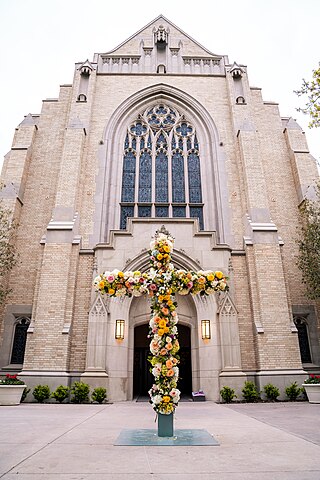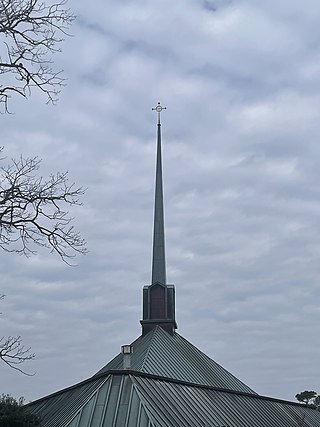
The Presbyterian Church (USA), abbreviated PCUSA, is a mainline Protestant denomination in the United States. It is the largest Presbyterian denomination in the country, known for its liberal stance on doctrine and its ordaining of women and members of the LGBT community as elders and ministers. The Presbyterian Church (USA) was established with the 1983 merger of the Presbyterian Church in the United States, whose churches were located in the Southern and border states, with the United Presbyterian Church in the United States of America, whose congregations could be found in every state.

The Presbyterian Church in America (PCA) is the second-largest Presbyterian church body, behind the Presbyterian Church (USA), and the largest conservative Calvinist denomination in the United States. The PCA is Reformed in theology and presbyterian in government.

The Cumberland Presbyterian Church is a Presbyterian denomination spawned by the Second Great Awakening. In 2019, it had 65,087 members and 673 congregations, of which 51 were located outside of the United States. The word Cumberland comes from the Cumberland River valley where the church was founded.
John M. Buchanan was the pastor of Fourth Presbyterian Church in Chicago, Illinois, United States, the second largest congregation in the Presbyterian Church (USA).

The New York Avenue Presbyterian Church was formed in 1859–1860 but traces its roots to 1803 as the F Street Associate Reformed Presbyterian Church and another congregation founded in 1820 on its current site, the Second Presbyterian Church.

The Covenant First Presbyterian Church is a congregation of the Presbyterian Church (USA) located at 717 Elm Street at Eighth Street and Garfield Place in Cincinnati, Ohio. Two churches, the First Presbyterian and Covenant Presbyterian merged in the 1933 to become the Covenant First Presbyterian Church.

The First Presbyterian Church of Hollywood is a Presbyterian Church (USA) congregation that has had a significant impact on both the Presbyterian Church and evangelical Christianity around the world.

The National Presbyterian Church is a Christian congregation of approximately 1,500 members of all ages from the greater metropolitan Washington, D.C. area. The mission statement of the church is "Leading People to Become Faithful Followers of Jesus Christ Together in God's World"

Fifth Avenue Presbyterian Church is a Presbyterian Church (U.S.A.) church in New York City. The church, on Fifth Avenue at 7 West 55th Street in Midtown Manhattan, has approximately 2,200 members and is one of the larger PCUSA congregations. The church, founded in 1808 as the Cedar Street Presbyterian Church, has been at this site since 1875.
The International Lutheran Church (ILC), now called the Redeemer International Congregation of the EECMY, is the English-speaking congregation of the Ethiopian Evangelical Church Mekane Yesus (EECMY) which meets in the Lidetta region of Addis Ababa, Ethiopia. Although it follows the Lutheran confession and worship, Redeemer welcomes any Christian worshippers.

Historic First Bryan Baptist Church is an African-American church that was organized in Savannah, Georgia, by Andrew Bryan in 1788. Considered to be the Mother Church of Black Baptists, the site was purchased in 1793 by Bryan, a former slave who had also purchased his freedom. The first structure was erected there in 1794. By 1800 the congregation was large enough to split: those at Bryan Street took the name of First African Baptist Church, and Second and Third African Baptist churches were also established. The current sanctuary of First Bryan Baptist Church was constructed in 1873.
West Presbyterian Church was a congregation and two houses of worship in Manhattan, New York City. The congregation was founded in 1829 and merged in 1911 with Park Presbyterian Church to form West-Park Presbyterian Church. The first house of worship, also known as the Carmine Street Presbyterian Church, in Greenwich Village, was used from 1832 to 1865, and the second, on West 42nd Street between Fifth Avenue and Sixth Avenue, from 1865 until 1911, when it was sold and demolished. Proceeds from the sale were used, in accordance with the merger agreement, to build and endow a church for an underserved neighborhood, Washington Heights: Fort Washington Presbyterian Church. In addition, the West Church congregation had earlier established two mission churches which eventually merged to become Good Shepherd-Faith Presbyterian Church. West-Park, Fort Washington, and Good Shepherd-Faith are all active today.

Old Kingsport Presbyterian Church is an historic church located in Kingsport, Tennessee. The church was organized May 20, 1820 as the Boatyard Congregation. It is the oldest one of any denomination in the city of Kingsport. It is a member of the Presbyterian Church (U.S.A.).

Bay Ridge United Church (BRUC) was located on Bay Ridge Parkway (636) in the Bay Ridge Section of Brooklyn, New York. The congregation was a blend of two churches from two similar but different denominations and was a member of both the Reformed Church in America and the Presbyterian Church (U.S.A.).

Park Cities Presbyterian Church (PCPC) is a Presbyterian Church in America megachurch in Dallas, Texas with about 5,500 members.

Highland Park Presbyterian Church is a Presbyterian church in University Park, Texas, with a Dallas post office address. In 2013, HP Pres voted to change its affiliation from Presbyterian Church (U.S.A.) to ECO: A Covenant Order of Evangelical Presbyterians.

First Presbyterian Church is a historic Presbyterian congregation in Hattiesburg, Mississippi, founded in 1882 by Rev. A. B. Coit. It was the first church in the town and predated Hattiesburg's own incorporation by two years. In 1973 it left the Presbyterian Church in the United States to become a charter member of the more theologically conservative Presbyterian Church in America.
Paul Smith is an American Presbyterian minister, mediator and civil rights activist known for creating multi-racial churches in Buffalo, St. Louis, Atlanta and Brooklyn, NY. Smith has been active in the civil rights movement since the 1950s. He has been an administrator, faculty member and trustee at seminaries and universities in St. Louis, Atlanta and New York City. He has served as a mediator and multicultural consultant to corporations and the government and has been active in organizations like the Urban League.

Westminster Presbyterian Church is in the Jefferson Park neighborhood of Los Angeles, California. Westminster Presbyterian Church is a member of the Presbyterian Church (U.S.A.), the Synod of Southern California and Hawaii and Pacific Presbytery. The congregation, established in 1904, is one of the oldest African American Presbyterian churches in California and west of the Mississippi River.

Westover Hills Presbyterian Church is a congregation of the Presbyterian Church (USA) in Little Rock, AR. Westover Hills is notable for its history in the Civil Rights struggle in Little Rock and the work of its then pastor Richard B. Hardie, Jr. in support of integration of the Little Rock Public Schools. The congregation continues to take public stances on many controversial issues including racial reconciliation, prisoners’ rights, and advocacy for LGBTQIA+ members of the community.















